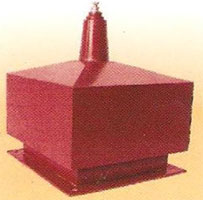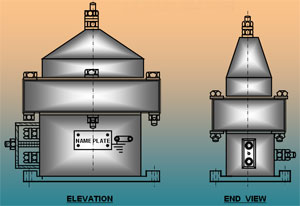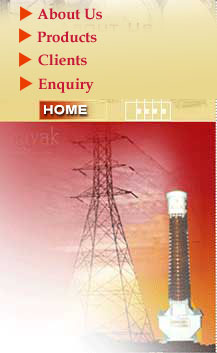General :
A
voltage transformer belongs to the shunt connected
class of electrical apparatus and is used so that
high systems voltages can be conveniently measured
by stepping them down to a value suitable for the
measuring instruments. For the Voltage Transformer
to be useful in this capacity, it is important that
the transformation ratio is accurately known and
also that the secondary voltage of the Voltage
Transformer is in phase with the voltage across its
primary. The various standard specifications list
the limits of permissible errors (Ratio Error and
Phase Displacement) for the various accuracy classes
of Voltage Transformers.
Voltage
transformers for dual purpose, metering and
protection, are also commonly used. An additional
secondary winding is provided which is connected in
open delta so that, in the event of an earth fault
on any of the phases, appropriate voltage is
developed across the open delta terminals which is
then use to actuate a tripping mechanism. Various
classes of accuracy for the protective duty, are
also included in the standard specifications.

 Single
phase Voltage Transformers. We have included Voltage
Transformers with only one secondary winding
suitable for metering and additional winding
(usually termed as the tertiary winding) can however
be included; although in such cases, an alternation
in the value of the rated burden on the metering
winding may be necessary.
Selection
of a Voltage Transformer :
The following points need to be considered while
selecting a Voltage Transformers.
Voltage
Transformer


(a)
Ratio :
This is the ratio of the rated primary voltage to
the rated secondary voltage. The rated primary
voltage is selected to be suitable for the system,
and is different depending upon whether the Voltage
Transformer is connected across lines or between
line and earth. Considering the particular case of
11kv. whereas for Voltage Transformer connected
across the lines the rated primary voltage will be
11kv 3.
The
secondary Voltage also changes depending upon the
mode of connection and is either 'Vs' or Vs/3.
We have standardized on a value of 110 Volts for VS
Although Voltage Transformers with Vs different from
110 Volts are also manufactured.
(b)
Rated Burden : This
in fact, is the 'load' expressed in VA, connected
across the secondary winding of a Voltage
Transformer if a number of meters are connected
across the Voltage Transformer the total burden on
the Voltage Transformer is merely an addition of the
load imposed by each meter. The burden values of the
meters are readily available from their
manufacturers and it is suggested that an estimate
of the total burden be made prior to the placement
or orders.
(c)
Class of Accuracy : Depending
upon the accuracy of voltage transformation Voltage
Transformers are classified into various classes by
the standard specification. The choice of an
accuracy class of the Voltage Transformers naturally
depend upon the duty it is called upon to perform.
We
as manufacturers of the Voltage Transformers have
certain limitations as to the class of accuracy
which can be obtained for certain rated burden. This
leaflet lists the accuracy classes for certain
standard values of rated burden.
Impulse
Voltage Withstand Test :
The Voltage Transformers listed here are normally
suitable for electrically non-exposed installations
and impulse voltage withstand test is not
applicable. The impulse test has, however been
successfully carried out on all designs as per I.S
Specification.
|



